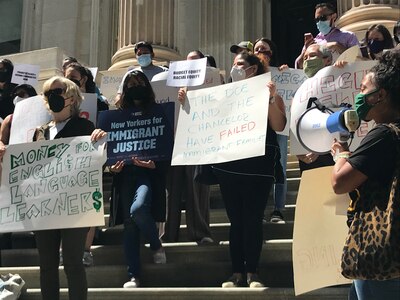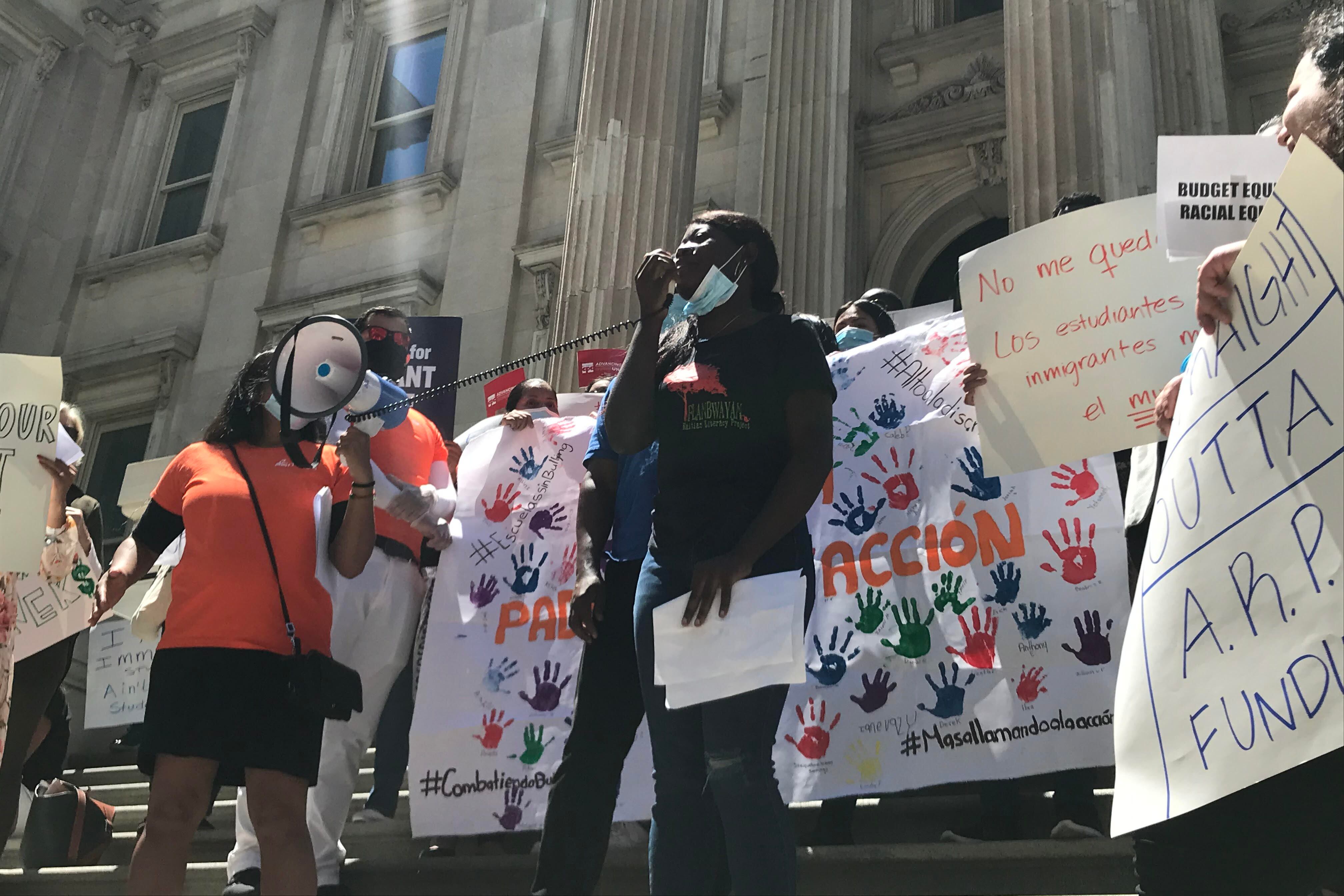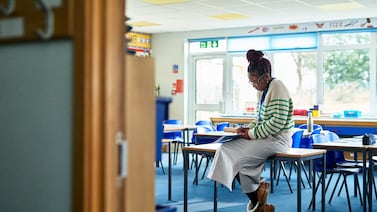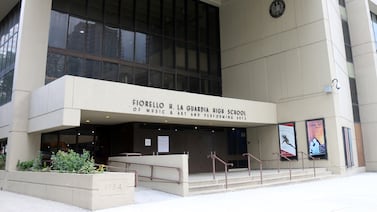A couple of months into the pandemic, Marleny De La Cruz lost her job as an office cleaner. Shortly after, her husband lost his supermarket job near their East Harlem home. She told herself there would be a silver lining: She could spend more time helping their 10-year-old son and 17-year-old daughter navigate remote learning through the tail end of the 2019-20 school year.
Being home full-time, however, didn’t solve the biggest hurdle for De La Cruz, who only speaks Spanish. Communicating with her children’s schools remained exceedingly difficult.
It wasn’t until this spring — nearly a year later — that her daughter’s high school in Queens set up De La Cruz with a translator during teacher phone calls, she said.
“It was really frustrating this year, and I’m still really unsure about what they did and what they didn’t learn,” De La Cruz said in Spanish through a translator. “I, as a mother, felt that I should have done more, and it was really upsetting and depressing to try to go to a meeting where you’re not going to understand anything about your son or daughter.”
Throughout the pandemic, communities with large immigrant populations were among the hardest hit, with disproportionately high infection rates. Many working-class immigrants like De La Cruz and her husband lost their jobs. On top of that, remote schooling presented a huge challenge for families who speak languages other than English to untangle problems with technology and questions about their children’s progress.
Now, ahead of Mayor Bill de Blasio’s plan to bring every child back into classrooms, advocates, families and educators say immigrant families and the 140,000 students learning English as a new language need extra communication, more one-on-one academic support and more socio-emotional services as they reacclimate to classrooms — as well as to regain any lost trust.
De Blasio’s proposed budget, expected to be finalized this week, allocates billions of federal COVID relief dollars toward education, including a $500 million initiative targeted at helping students catch up. But officials have not outlined a specific plan for how they’ll support English language learners.
Advocates find that problematic, especially because these students continue to have the highest dropout rate among student subgroups, and may need extra support following a year marred by spotty internet access, communication barriers with schools, and more responsibilities for students — such as work or babysitting younger siblings — that may have disrupted their focus on school.
“We will provide opportunities to accelerate learning and evaluate the needs of all students, including ELLs, as we recover from the impacts of the pandemic, and we’re investing in targeted summer supports for these students to meet their unique needs,” wrote Sarah Casasnovas, a spokesperson for the education department, in a statement.
Improving communication
Schools have long struggled to communicate with families who don’t speak English as their primary language, but the language barrier was especially daunting this year as pandemic-related guidance and schedules shifted often. Some of the spaces where schools shared this information and provided a forum for families to ask questions, such as Parent Teacher Association meetings, were not accessible to families who speak little English.
Many families didn’t even have the information about the city’s special summer school program, open to all students, said Vanessa Luna, co-founder of Imms Schools, which holds family workshops and provides professional development for educators on supporting immigrant students. At New Utrecht High School in Brooklyn, where nearly 20% of students are English language learners, teacher Nathan Floro had to print out and deliver COVID testing consent forms to families who were not native English speakers and couldn’t navigate the form online.
Communication problems appear to have persisted throughout the pandemic. A survey conducted by the New York Immigration Coalition in summer 2020 found that one-third of 100 parent respondents had not received information or assignments from their child’s school in the language they speak at home. Nearly 30% of families said at the time that their schools had not shared plans for the 2020-2021 school year.
The education department says that over-the-phone interpretation services are available 24/7 in 350 languages for schools staff to communicate with families, but advocates have found many instances like De La Cruz’s, where those services aren’t used.
“Currently we hear these cases every day — that they weren’t given an interpreter,” said Andrea Ortiz, education policy manager at the New York Immigration Coalition. “That right there means it hasn’t been implemented.”
The Education Collaborative, a coalition of advocacy organizations that support immigrant New Yorkers, are pushing for $45 million in the city’s budget for next fiscal year, which begins July 1, to improve school communication with families. This includes putting more school communication on paper, doing more outreach through telephone calls and on WhatsApp and WeChat, and marketing campaigns that place school information in places immigrants frequent, such as houses of worship. They also want every school to have interpretation equipment for town halls or PTA meetings, money for community-based organizations to do outreach, a language telephone line for uncommon, indigenous languages, and a program in community schools that pays parents and students to help communicate with people at the school.
A spokesperson for the education department said officials have tried to close the “communication gap” by translating letters sent to families — as well as their web page and social media posts — into 10 languages. They’ve also turned to “multilingual” media outlets to share updates about devices or remote learning, and also held live workshops for families in languages other than English in partnership with community organizations and the Mayor’s Office of Immigrant Affairs.
But advocates argue that immigrant families who don’t use email, especially those speaking less common languages or dialects, are often unaware of those efforts.
Bolstering academic support
Many older immigrant students had to work to support their families, sometimes becoming the sole breadwinners after parents lost jobs, meaning sometimes they couldn’t show up to class. Officials with New York Immigration Coalition and Advocates for Children New York said schools have “admitted” to them that they have not been providing all of the hours of extra language support that English learners are entitled to receive because they didn’t have enough staff during hybrid learning, which required teachers for both in-person and remote schooling.
One analysis found that in January of this year, English language learners in high school had attendance rates that were eight percentage points on average lower than their native English-speaking peers. (Attendance meant anything from showing up on Zoom to answering a teacher’s phone call.)
George Badia, principal at Elmhurst’s Pan American High School, which exclusively serves new immigrant students in a community that was one of the hardest hit by the coronavirus, recently held a town hall with parents to remind them of social services and food benefits available to families so children feel less pressure to work and not show up to class in the fall.
Many of Badia’s 386 students have said that they need more English literacy support and help with math. The school has already started paying teachers overtime for one-on-one tutoring and has hired peer mentors to encourage students to show up to class, he said. Next year, they plan to use a bump in school funding for Saturday classes and other tutoring supports, as well as more advisory sessions for students.
With a funding increase across most schools, many may be able to hire more teachers or pay for extra services for students. But advocates want to see more targeted support. The Education Collaborative wants $78 million to go toward a suite of academic help, including one-on-one and small group literacy development for this summer, and after-school and weekend classes during the school year for both English learners and students with parents who don’t speak English. They also want to establish mentorship and peer tutoring for newcomer English learners.
Some educators want a key part of next year to focus on socializing because it is an important part of practicing a new language. This will be key for newer immigrants who haven’t had a chance to get to know their schools and their neighborhoods because of the pandemic, they said.
Teachers said they will assign more group work in the fall, focus more on oral assignments so that students can practice speaking, and will take students on field trips to explore their school’s neighborhood more and so they can use the language outside of a classroom.
“We need to provide not just test prep, but really provide room for authentic socialization and just individualized attention,” said Eleni Filippatos, an elementary English as a new language teacher in Washington Heights. “Every kid is different, every kid has been through something different during this.”
Over the summer, the department has promised to provide English as a new language curriculum for English learners at Summer Rising sites across the city and will hire more teachers who are trained to support these students. They also pointed to their plan to partner with community organizations, who will be charged with creating enrichment activities for students, including English learners.
In the fall, department officials said they plan to ensure multilingual learners are on track to graduate and have “equitable access” to college and career pathways, and plan on “strengthening partnerships” with immigrant families and communities – but a spokesperson didn’t specify how they’ll achieve these things.
Leaning on community-based organizations
Education Collaborative also wants the city to earmark an additional $20 million in grants for community-based organizations, to help provide extra academic support next year, since many filled in that gap over the past two school years.

High school junior Kelitha Nazaire, an English language learner, said it was tough to get extra support from her teachers in a remote environment, especially because some only speak English. So she turned to Flanbwayan, a community-based organization where she is a youth member. It supports older immigrant students which started also providing extra support to younger students in response to the pandemic.
“I had to get to Flanbwayan every day to do my work [but] not everyone has a safe place to go,” Nazaire said during a recent rally for immigrant students.
The Brooklyn-based Arab-American Family Support Center, which provides academic support to largely immigrant families, saw such an “incredible uptick” in people asking for help with school that they created a wait list. They helped English learners with homework, figuring out college applications, translate conversations between teachers and families who spoke little English, and created peer support groups for those who were feeling isolated.
“They were turning to organizations like ours to help fill in that gap,” said Kerry Sesil, the center’s senior director of resource development.
Supporting social emotional needs
At Pan American in Elmhurst, principal Badia can list from memory the 15 students who have reported losing relatives, including parents to COVID. Early on the school surveyed every student about their stress levels and developed a counseling plan for each student, if needed.
“We are seeing an increase in students and families looking for services,” Badia said.
The mayor has proposed spending $93 million to ensure every student can be screened for social-emotional needs at the start of the school year, as well as placing a full-time social worker in every school without one or without access to a school-based mental health clinic.
But advocates, students and families believe that social workers and guidance counselors must be able to communicate with students and understand the cultural perspectives they’re coming from.
As this school year wore on, Sarah Factor, a middle school English as a new language teacher in Manhattan’s District 2, could see how physically exhausted her students looked. Her newcomer immigrant students had not had a chance to meet their peers or get acclimated to school, and some students’ relatives had died from COVID.
How, she thought, could schools expect these students to be motivated to learn a new language?
“If we’re all back in the fall, kids who haven’t been inside a school building for a year and half are gonna have vastly different needs,” Factor said. “It’s gonna be a culture shock situation.”
Nazaire, who came to New York City from Haiti five years ago, said she and her peers have found it tough to confide in guidance counselors because they don’t speak their language.
Some schools do an “incredible job” with social-emotional support, said Luna, from Imms schools. But Luna is also in touch with a family who has reported that their child’s school “never shared there are counselors available, never shared there are translators available.”
A spokesperson for the education department said there are roughly 300 bilingual guidance counselors employed in city schools — about 10% of all guidance counselors.
De La Cruz, the parent from East Harlem, said her 17-year-old daughter has been talking to a counselor at her Queens high school, but there were times the counselor would delay or cancel on her. The school finally provided an interpreter for De La Cruz this spring because her daughter was falling behind with school work, she said. Previously, she relied on her eldest son, a 25-year-old juggling his own work and college, to interpret during teacher meetings and would sometimes need to cancel if he wasn’t available.
Even with the interpretation service, De La Cruz found it hard to ask many questions about her daughter’s progress, feeling rushed on the “quick call with a translator.”
“This year was really tough for her, and I don’t think she feels good in that school,” De La Cruz said. “Maybe I can engage better if she’s closer in the neighborhood, and if I’m able to translate better.”





